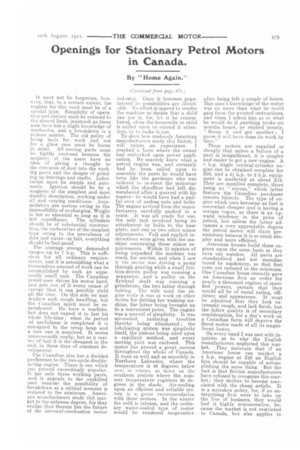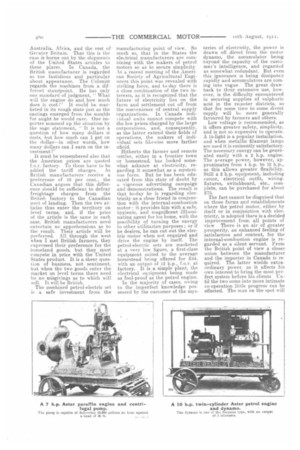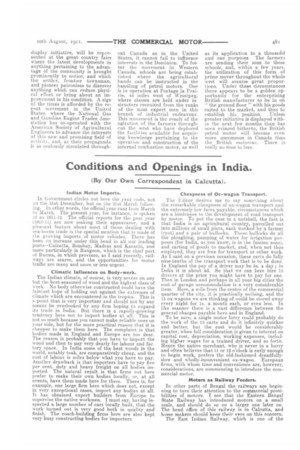Openings for Stationary Petrol Motors in Canada.
Page 3

Page 4

Page 5

If you've noticed an error in this article please click here to report it so we can fix it.
By "Home Again."
It must not be forgotten, however, that to a certain extent, the engines for this work must be of a special type. Simplicity of operalien and control must be reduced to the absurd limit, inasmuch as these men have but a slight knowledge of mechanics, and a breakdown is a serious matter. The old policy of being built for work and not for a glass ease must be borne in mind. All moving parts must be tightly enclosed because the majority, of the users have no idea of giving a thought to the entrance of dust into the working parts and the danger of grinding up bearings and shafts. Lubrication must be simple and automatic, Ignition should be by a magneto of the simplest and most durable description, working under all and varying conditions. Accumulators are useless owing to the impossibility of re-charging. Weight is not so essential so long as it is not superfluous. The cylinders should be of substantial construction, the carburetter of the simplest t,,pe owing to the prevalence of dust and water—in fact, everything should he fool-proof.
The average energy demanded ranges up to 7 h.p. This is sufficient for all ordinary requirements, and it is astonishing what a tremendous amount of work can be accomplished by such an apparently small unit. The Canadian power-user drives his motor hard, and gets out of it every ounce of nnergy that it can possibly yield all the time. On this side we may deplore such rough handling, but the Canadian spirit must be remembered. He buys a machine, but does not expect it to last his whole life-time ; when its period of usefulness is completed it is consigned to the scrap heap and a new one is acquired.. It seems unnecessarily costly, but as a matter of fact it is the cheapest in the end, in these days of constant development, The Canadian also has a decided preference to the two-cycle doubleacting engine. There is one which has proved exceedingly popular. It has only three working parts, and it, appeals to the unskilled user because the possibility of breakdown at a critical moment is reduced to the minimum. American manufacturers study thit market to the extreme degree, for they realize that therein lies the future of the internal-combustion motor industry. Once it becomes popularized its possibilities are illimitable. No effort is spared to render the machine so simple that a child can use it, for, let it be remembered, often the housewife or child is called upon to extend it attention, or to make it run.
To show how zealously American manufacturers study this factor, I will relate an experience. I reached a farm where the owner had embarked upon power application. He scarcely knew what a petrol engine was, and certainly had he been called upon to assemble the parts he would have been like the gardener who was ordered to re-erect the motorcar which the chauffeur had left dismembered after a quarrel with his master—he would have had a pailful over of useless nuts and bolts. The engine arrived from the manufacturers carefully packed in a crate. It was all ready for use, the only task involved being its attachment by bolts to the -base plate, and one or two other minor adjustments. Full and explicit instructions were given with the machine concerning these minor requirements. Within 15 minutes of being unpacked the machine was ready for service, and when I saw it the motor was driving a pump through gearing while a small friction-driven pulley was running a separator, and a pulley on the flywheel shaft was running a grindstone, the two latter through belting. The wife used the engine while it was at work on other duties for driving her washing machine, the latter being brought up to a convenient point. The engine was a marvel of simplicity. It was air-cooled, radiating troubles thereby being eliminated ; the lubricating system was simplicity itself, the pistons being oiled upon a capillary method, and every moving part was enclosed. This motor has proved a great success throughout the whole of Canada_ It runs as well and as smoothly in Northern Labrador, where the temperature is 40 degrees below zero in winter, as down on the southern prairie where the summer temperature registers 90 degrees in the shade. Air-cooling upon an efficient and reliable system is a great recommendation with these motors. In the winter the cold is intense, and the ordinary water-cooled type of motor would be rendered inoperative
after being left a couple of hours. This man's knowledge of the motor was no more than what he could gain from the printed instructions, and when I asked him as to what he would do if anything broke six months hence, he replied tersely, " Scrap it and get another ; I guess it will have done its work by 'then."
These motors are supplied so cheaply that unless a failure of a part is insignificant, it is simpler and easier to get a new engine. A 4 h.p. single vertical-cylinder engine can be obtained complete for
220, and a h.p. to 2 h.p. equipment is marketed at about 212. They are supplied complete, there being no " extras," which latter feature the Canadian purchaser resents bitterly. The type of engine which uses kerosene as fuel is somewhat cheaper and is having a certain vogue, as there is an upward tendency in the price of petrol, but unless the latter advances a very appreciable degree the petrol motor will claim preeminence because it is so much simpler and more efficient.
American houses build these engines upon the same basis as they turn out watches. All parts are standardized and are manufactured by machinery, so that first costs are reduced to the minimum. One Canadian house recently gave an American firm an order for nearly a thousand engines of specified powers, certain that they wouldall be of equal rating, efficiency and appearance. It must be admitted that they look extremely rough, and lack finish, but the latter quality is of secondary consideration, for a day's work on a Canadian farm will deprive the finest motor made of all its magnificent lustre.
On every hand I was met with inquiries as to why the English manufacturers neglected this market. They maintain that if an American house can market a 4 h.p. engine at £20 an English firm should be capable of accomplishing the same thing. But the fact is that British manufacturers have refused to recognize this market; they decline to become associated with the cheap article. It is a mistaken policy, for, if an enterprising firm were to take up the line of business, they would find it highly remunerative, because the market is not restricted to Canada, but also applies to Australia, Africa, and the rest of Greater Britain. That this is the ease is borne out by the shipments of the United States articles to these places. In Canada, the British manufacturer is regarded as too fastidious and particular about appearance. The Colonist regards the machines from a different standpoint. He has only one standard of judgment, " What will the engine do and how much does it cost ?" It could be marketed in its rough state just as the castings emerged from the moulds for aught he would care. One importer summed up the situation by the sage statement, " It is not a question of how many dollars it costs, but how much can I get on the dollar—in other words, how many dollars can I earn on the investment?"
It must be remembered also that the American prices are quoted f.o.r. factory. To these have to be added the tariff charges. As British manufacturersreceive a preference of 10 per cent., the Canadian argues that this difference should be sufficient to defray freightage charges from the British factory to the Canadian port of landing. Then the two articles thus enter the territory on level terms, and, if the price of the article is the same in each case, British manufacturers need entertain no apprehensions as to the result. Their article will be preferred. All through the west when I met British farmers, they expressed their preference for the homeland goods, but they must compete in price with the United States product. It is a sheer question of business, not sentiment, but when the two goods enter the market on level terms there need he no misgivings as to which will sell. It will be British.
The combined petrol-electric set is a safe investment from the manufacturing point of view. So much so, that in the States the electrical manufacturers are combining with the makers of petrol motors so as to secure simplicity. At a recent meeting of the American Society of Agricultural Engineers this point was revealed with striking force, and to-day there is a close combination of the two interests, as it is recognized that the future of electricity lies on the farm and settlement cut off from the convenience of central supply organizations. In Canada individual units cannot compete with the low prices charged by the large corporations, and, consequently, as the latter extend their fields of operations, the makers of individual sets likewise move farther afield.
Hitherto the farmer and remote settler, either in a frontier town or homestead, has looked somewhat askance at electricity, regarding it somewhat as a mysterious force. But he has been educated from this state of doubt by a vigorous advertising campaign and demonstrations. The result is that to-day he is regayding electricity as a close friend in conjunction with the internal-combustion motor : it provides him with a safe, hygienic, and magnificent illluminating agent for his home, with the possibility of turning the energy to other utilitarian purposes ; or if he desires, he can cut out the electric motor when not required and drive the engine by itself. The petrol-electric sets are marketed at a very low figure, a first-class equipment suited to the average homestead being offered for £44, with an output of 12 h.p., for. at factory. It is a simple plant, the electrical equipment being made as fool-proof as the petrol engine. In the majority of cases, owing to the imperfect knowledge possessed by the customer of the mys teries of electricity, the power is drawn off direct from the motor dynamo, the accumulator being beyond the capacity of the customer's intelligence, and regarded as somewhat redundant. But even this ignorance is being dissipated rapidly and accumulators are coming into vogue. The great drawback to their extensive use, however, is the difficulty encountered in securing supplies of sulphuric acid in the remoter districts, so that for some time to come direct supply will be more generally favoured by farmers and others.
Low voltage is recommended, as it offers greater safety, simplicity, and is not so expensive to operate. A 15-light is a popular installation, and when metallic filament lamps are used it is eminently satisfactory. The necessary energy can be generated easily with a 2 h.p. engine. The average power, however, approximates from 4 h.p. to 12 h.p., as this allows greater flexibility. Still a 2 h.p. equipment, including motor, electrical outfit, wiring. fixtures, switchboard, etc., complete, can be purchased for about £75.
The fact cannot be disguised that on those farms and establishments where the petrol motor, either by itself or in conjunction with electricity, is adopted there is a decided improvement from all points of view There is an air of greater prosperity, an enhanced feeling of satisfaction and content, for the internal-combustion engine is regarded as a silent servant. From the British point of view a closer union between the manufacturer and the importer in Canada is required. The latter wields extraordinary power, as it affects his own interest to bring the most perfect system before his clients Un • til the two come into more intimate co-operation little progress can be effected. The man on the spot will
aiisplay initiative, will be represented at the great country fairs where the latest developments in anything pertaining to the advantage of the community is brought prominently to notice, and which the settler, frontier townsman, and pioneer patronizes to discover anything which can reduce physical effort or bring about an improvement in his condition. A sign of the times is afforded by the recent movement in the United States, where the National Gas and Gasoline Engine Trades Association has co-operated with the American Society of Agricultural Engineers to advance the interests of this new and promising field of activity, and, as their propaganda is as zealously circulated through out Canada as in the United States, it cannot fail to influence interests in the Dominion. To foster the movement in Western Canada, schools are being established where the agricultural hands. can be instructed in the handling of petrol motors. One IS in operation at Portage in Prairie, 44 miles west of Winnipeg, where classes are held under instructors recruited from the ranks of the most expert men in this branch of industrial endeavour. This mos ement is the result of the agitation of the farmers throughout the west who have deplored the facilities available for acquiring knowledge pertaining to the operation and construction of the internal-combustion motor, as well as its application to a thousand and one purposes. The farmers are sending their sons to these schools, and, within a few years, the utilization of this form of prime mover throughout the whole west will assume great proportions. Under these circumstances there appears to be a golden opportunity for the enterprising British manufacturer to be in on "the ground floor" with his goods suited to the market, and thus to establish his position. Unless greater initiative is displayed within the next few months than has oeen evinced hitherto, the British petrol motor will become even more uncommon in Canada than the British motorcar. There is really no !Arne to lose.


















